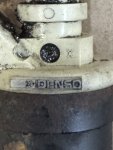TonyLittell
Active Member
- Joined
- Jan 6, 2025
- Messages
- 40
- Vehicle Year
- 1988
- Engine
- 2.3 (4 Cylinder)
- Transmission
- Automatic
Hey guys, need some more advice on this truck of mine. Been sitting for years and I talked my wife’s father out of the truck to make a spare vehicle.
88 regular cab long bed xlt 2.3 auto
Truck has spark, will run on starting fluid.
Replaced Fuel pump relay, EEC relay, fuel filter, inline fuel pump, fuel injectors (denso replacements) fuel pressure regulator. Also replaced plugs, wires, cap and rotor.
I have also put fresh oil at the correct level.
The plugs are dry and don’t even smell like fuel even a little bit
Still not getting fuel past the injectors. I checked fuel pressure at the rail and it’s getting 40psi. I have taken my injector tester and set it on number 8 setting and connected to the injectors individually and it pushes fuel into the cylinder.
I have put a test light on the injector connector and it turns the light on and off.
when I put a meter on the connector it sends voltage all over the place. I put the meter on ohms and it reads 16ohms.
I’m just not sure my next step here. Any help/suggestions would be super appreciated!
88 regular cab long bed xlt 2.3 auto
Truck has spark, will run on starting fluid.
Replaced Fuel pump relay, EEC relay, fuel filter, inline fuel pump, fuel injectors (denso replacements) fuel pressure regulator. Also replaced plugs, wires, cap and rotor.
I have also put fresh oil at the correct level.
The plugs are dry and don’t even smell like fuel even a little bit
Still not getting fuel past the injectors. I checked fuel pressure at the rail and it’s getting 40psi. I have taken my injector tester and set it on number 8 setting and connected to the injectors individually and it pushes fuel into the cylinder.
I have put a test light on the injector connector and it turns the light on and off.
when I put a meter on the connector it sends voltage all over the place. I put the meter on ohms and it reads 16ohms.
I’m just not sure my next step here. Any help/suggestions would be super appreciated!
Last edited:














